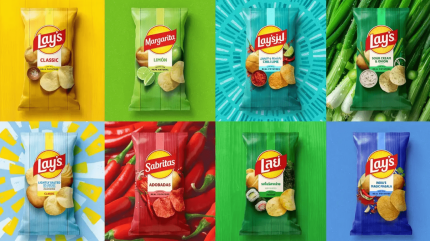
PepsiCo has unveiled what it calls the largest brand redesign in Lay’s nearly 100-year history, pairing a new visual identity with reformulated recipes and updated packs.
Announced on 9 October 2025 in the United States, the Lay’s packaging redesign aligns with the federal “Make America Healthy Again” (MAHA) initiative and will phase in across core SKUs through 2025, with further portfolio changes slated for 2026.

Discover B2B Marketing That Performs
Combine business intelligence and editorial excellence to reach engaged professionals across 36 leading media platforms.
The move places packaging, labelling and ingredient changes at the centre of a broader brand refresh aimed at modernising shelf presence and clarifying on-pack claims for health-minded shoppers.
Visual identity: warmer sun, ingredient-led colour system and farm imagery
The new Lay’s visual identity introduces a warmer, more distinct sun device with radiating “Lay’s Rays” that reference potato growing conditions.
Packs adopt a refined colour palette derived from recipe ingredients, with close-up photography designed to emphasise chip texture, seasoning and golden tones.
The brand says the redesign prioritises billboarding and legibility at distance, supported by a custom typeface and a matte pack finish to reduce glare under retail lighting.

US Tariffs are shifting - will you react or anticipate?
Don’t let policy changes catch you off guard. Stay proactive with real-time data and expert analysis.
By GlobalDataFor packaging teams, the artwork system signals a shift toward ingredient-anchored colour management and consistent hierarchy for flavour cues.
The farm-led imagery and simplified front-of-pack layouts are intended to improve variant navigation and SKU differentiation while maintaining strong brand blocks on shelf—key goals for any snack packaging redesign.
Formulation updates drive new on-pack claims and timelines
Alongside the brand refresh, PepsiCo plans recipe changes that will influence front-of-pack nutrition and claims architecture. By the end of 2025, all core Lay’s products in the U.S. are slated to be made without artificial flavours or colours from artificial sources.
Lay’s Baked will move to olive oil and carry a “50% less fat than regular potato chips” claim, while a new Lay’s Kettle Cooked Reduced Fat Original Sea Salt variant will use avocado oil with “40% less fat” than regular chips. The company indicates more options across its food portfolio will debut in 2026.
These formulation shifts will require careful coordination between packaging development, regulatory review and supply chain.
Teams will need to validate new ingredient declarations, update nutrition panels, and ensure consistency of “no artificial flavours or colours” messaging across formats and print technologies.
For reduced-fat SKUs using olive or avocado oil, claims substantiation, font sizing and placement against local labelling rules will be critical to avoid pack reworks.
Operational considerations for printers, converters and retailers
The Lay’s packaging redesign—spanning a global nameplate with U.S.-led timelines—implies significant artwork versioning, cylinder and plate changes, and potential substrate adjustments to achieve the matte finish and photography fidelity. Converters should anticipate:
- Pre-press and colour management: Ingredient-led palettes and high-contrast chip macros will demand tight ICC profiling and press characterisation to preserve warmth without colour cast. Expect expanded spot colour libraries or finely tuned CMYK builds for consistent brand blocks across film structures.
- Material and finishing choices: A move to matte finishes can affect scuff resistance and brightness. Printers may need protective over-varnishes or higher-opacity whites to maintain shelf impact, particularly on metallised films.
- Claim harmonisation and inventory run-down: Transitioning to “no artificial flavours or colours” and reduced-fat statements requires coordinated depletion of legacy film to mitigate write-offs. Clear cut-over dates and retailer communication plans will reduce mixed facings.
- Retail execution: The simplified front-of-pack and stronger billboarding aim to improve planogram compliance and velocity. Category managers should evaluate how the new packs affect read distance and flavour shopability in both clip-strip and multipack displays.
Industry observers have characterised the shift as a notable brand refresh given Lay’s previous major overhaul was nearly a decade ago.
From a packaging perspective, the emphasis on visual clarity, clean-label signalling and farm-origin cues mirrors wider snack category trends, where on-pack transparency and reduced-additive messaging are now common search and shelf keywords.





